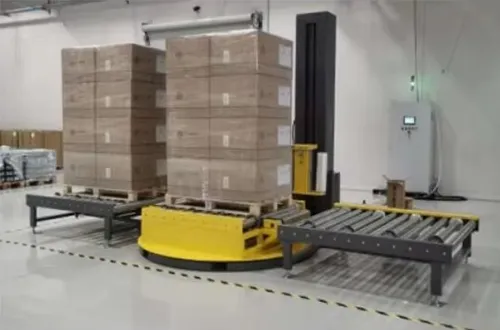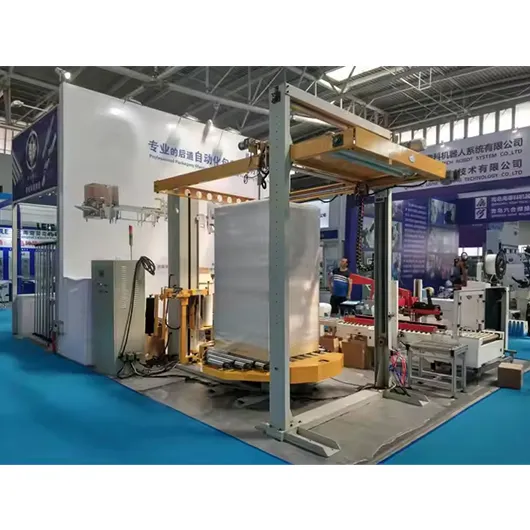Avoid your inquiry is delay response, please enter your WhatsApp/Skype along with the message, so we can contact you at the very first time.
We will reply you within 24 hours. If for urgent case, please add WhatsApp/WeChat: ,. Or call directly.
Tired of loose film, damaged boxes, and aching backs? The problem is manual wrap. It’s slow, inconsistent, and costly. Aggravating, right? The solution is a stretch wrap machine—simple, safe, and built to secure every load.
A stretch wrap machine uses stretch film to apply a tight wrap around a pallet or product so it arrives intact. It improves consistency, cuts film use, and boosts speed compared to hand wrap. Choose a turntable, rotary arm, or orbital style based on load weight, stability, and throughput.

A stretch wrap machine pulls stretch film under tension and applies the wrap in layers to stabilize the load. In seconds, the film grips, stretches, and locks down corners. Modern wrapping machines use programmed cycles to start, stop, and cut film automatically, giving repeatable results on every pallet.
Here’s the flow: set the wrap pattern, place the pallet, and press start. The film carriage moves while the turntable spins (or the arm rotates), building a tight stretch wrap shell. Many systems include film clamps and auto-cutters. An automatic stretch wrap cycle can even be triggered by a sensor as the pallet arrives on the infeed conveyor.
When you use machines to wrap pallets, you standardize containment force and improve pallet wrapping quality—key to reducing transit damage and returns.
Choosing between semi-automatic stretch and automatic wrapping machines depends on your volumes, labor plan, and line layout. Semi-automatic stretch wrap units are operator-led: you place the pallet and start the cycle. Automatic models integrate conveyors and PLC logic to feed, wrap, and discharge with minimal touches—ideal for multi-shift packaging operations.
If you’re exploring a proven starting point, see a semi-automatic pallet wrapping machine and a higher-throughput automatic pallet wrapping machine.
Many buyers say “semi” or “semi-auto” when they mean semi-automatic. A semi-automatic stretch wrapper offers fast ROI and control without a full conveyor line. Typical semi-auto machines add cycle memory, auto film cut, and adjustable wrap patterns. You’ll also see the semi-automatic stretch wrap machine benefits in safety and consistency versus hand wrap.
Tip: If you want a quick upgrade path, start with a semi-auto stretch wrap machine and add conveyors later. It’s a low-risk bridge to automatic operation when volumes rise.

Turntable machines spin the pallet; they’re compact and affordable. Rotary arm systems keep the pallet stationary, ideal for tall, light, or unstable goods. Orbital wrappers feed film through a rotating ring to secure long items like doors, pipes, or boards. Each stretch style fits different floors and loads.
Compare in action: an automatic horizontal orbital stretch wrapping machine excels on elongated items, while an electric pallet turntable upgrades ergonomics on existing lines. For reference, industry guidance notes that turntable wrappers rotate the pallet, while straddle/arm systems stabilize difficult pallet loads without rotation.
“Choose the machine that moves the film—not the product—when stability matters most.”
If your mix is mostly boxes on standard skids, a pallet wrapping machine with a turntable is a smart baseline.
Let’s summarize the main features that secure and protect freight:
These are the building blocks of wrapping machines with real reliability. Many lines also include photoeyes, top-press plates, and automation hooks for MES/PLC integration. For compliance-minded teams, ISTA transit testing validates that your stretch packaging can survive shipping shocks and vibration.
Pre-stretch multiplies film length before application. A pre-stretch carriage uses gears or motors to elongate film (for example, 200–300%), tightening containment force while reducing costs. Real-world calculators show aggressive pre-stretch can cut film spend dramatically over time, especially as loads per shift climb.
Film Savings (illustrative)
No pre-stretch | ██████████████
200% pre-stretch| ███████
300% pre-stretch| █████
Manufacturers report common machine films designed to comfortably stretch to ~300%—a practical ceiling for many jobs. And ROI examples show significant lifetime savings when moving from minimal hand pre-stretch to machine-level ratios.
Dial in wrap height to cover the top layers without crushing cartons. A recipe-driven control panel makes this easy: save bottom wraps, top wraps, dwell times, and film force for each SKU. Train operators to check corners and edges where punctures happen.
Safety matters. Good practice reduces strain for warehouse crews. Engineering controls—like powered wrapping machines and lift tables—are OSHA-recommended to minimize repetitive bending, twisting, and lifting associated with manual wrap tasks.
Let’s keep the math simple. Throughput rises when the machine controls the cycle and film delivery. Entry automatic stretch wrappers often run ~35–50 loads per hour depending on settings and line design, while advanced ring systems can surpass that.
The result? Higher productivity with less fatigue compared to manual hand wrapping. Operators focus on exceptions and quality checks instead of wrestling film all day.
A heavy duty turntable model handles tough jobs, pairing high lb load capacity (e.g., 4,400 lb) with reinforced bearings. If you ship machinery or stone, you need the right stretch frame and mast. That’s how you protect heavy loads and minimize damage on the road.
Watch your overall pallet geometry and fork-clearance, too—especially with very dense pallet loads. When weight or height is extreme, consider a rotary arm system so the load doesn’t spin.
A fully automatic line adds conveyors, guards, and interlocks to feed, wrap, and discharge with almost no operator touches. A stretch wrapping system like a conveyorized line can be the right choice once you scale past a mid-level turntable machine. For reference, in-line solutions can hit higher speeds; select options by actual product mix and quality targets.
Explore a fully-automatic conveyorized in-line stretch film pallet wrapping machine. In some high-speed designs, ring or arm machines push the envelope; that’s fully automatic stretch performance when your line needs to surge.
Not all films act the same. Gauge, resin blend, and cling all affect how the wrap holds. Match film to the product: sharper edges need tougher specs; soft goods may accept lighter film. If you run specialty shapes, stretch film machines (orbital or ring) can improve coverage with less film and cleaner tails.
Good packaging practice sets a baseline recipe: top wraps, bottom wraps, and an overlap plan. Test to your actual damage modes and dial in film force—then lock it in with the machine’s program.
We’re a professional manufacturer of automatic packaging machines, and we build machinery that’s easy to own. Our engineer-led approach emphasizes simplicity, service access, and parts availability. That’s how we deliver reliability and best value over the long haul—whether you’re launching your first cell or upgrading a network of sites.
Want mobile flexibility? A robot stretch wrapper goes to the load instead of the other way around. Need accessories? An electric pallet turntable can retrofit into existing cells to improve ergonomics. If you’re unsure, talk to a packaging specialist about automatic and semi-automatic options to find the right fit.

Here’s a short list to compare stretch wrappers and stretch wrapping options and wrappers and stretch wrapping equipment side by side:
For elongated products, consider an automatic horizontal orbital stretch wrapping machine. For standard skids, review the automatic pallet wrapping machine and the semi-automatic pallet wrapping machine.
This is all packaging equipment you can scale as your network grows.
A consumer-goods DC moved from hand wrapping to a mid-level turntable machine. In three weeks, they standardized wrap recipes and cut film usage ~25% while hitting quality goals. Operators reported less strain and faster bay turns. Next, they plan to add a top-sheet and integrate with WMS to track loads per hour.
If your volumes spike seasonally, start with a semi-auto turntable stretch wrap machine and reserve the option to go in-line later. That’s often the fastest route to stable stretch quality.
| Category | Entry Semi-Auto | In-Line Fully Automatic | Mobile Robot |
|---|---|---|---|
| Typical Speed (pallets/hr) | 15–25 | 35–60+ | 20–30 |
| Film Delivery | 200–300% pre-stretch | Motorized pre-stretch | Motorized pre-stretch |
| Footprint | Small | Larger with guards | Minimal (travels) |
| Best Use | Mixed SKUs | High volume | Overflow/aisles |
Numbers are representative; verify against your actual SKUs and test results. High speed units exist for specialized lines; some ring machines exceed these figures when configured correctly.
For specialized shapes, see the coil/pipe/tyre stretch film wrapping machine. For in-line cells with top-sheeting, review the fully-automatic conveyorized in-line stretch film pallet wrapping machine.
What’s the difference between a turntable and a rotary arm?
A turntable spins the load; a rotary arm spins the film around a stationary pallet. Choose arm for unstable or heavy items; choose table for most mixed freight.
How fast can automatic lines run?
Entry systems often reach 35–50 pallets/hour; high-end ring/arm gear can go much faster when engineered correctly. Match speed to product stability and quality targets.
Will pre-stretch hurt my boxes?
No—done right, pre-stretch improves containment without crushing. Machine films commonly run up to ~300% stretch; test your settings on real SKUs.
Can this reduce injuries from hand wrapping tasks?
Yes. Replacing manual wrap with engineered solutions cuts repetitive bending and twisting. That’s a recognized control approach for ergonomic risk.
What if I need to move the machine?
Consider a mobile robot or a stationary arm with powered conveyors. Both can be engineered for your space and packaging flow.
Where does “stretch wrapping faq” belong in my SOP?
Keep a short “stretch wrapping faq” in your work instructions so operators know recipes, film specs, and safety steps at a glance.
| Decision | Choose This | Why |
|---|---|---|
| Light-to-medium SKUs | Turntable style | Compact, budget-friendly |
| Unstable or heavy loads | Rotary arm | Keep load still |
| Long items | Orbital | Better coverage |
| Highest speed | In-line fully automatic | Guarded conveyors |
“We design wrapping machines to be simple to run and simple to maintain. That’s how we help you secure and protect freight every day.”